Introduction: Navigating the VUCA Landscape
As the world is moving towards hyper-active technological disruption, its high time for Project Managers to learn effective ways to deliver value in a VUCA environment. There are plethora of examples demystifying the concept of VUCA. But very few revitalizing its impact on project management and value delivery. This article is framed to have a clear picture on how it works, the balancing act, mindset and delivering value from a Project, Program, Portfolio Manager Perceptive.
Understanding VUCA
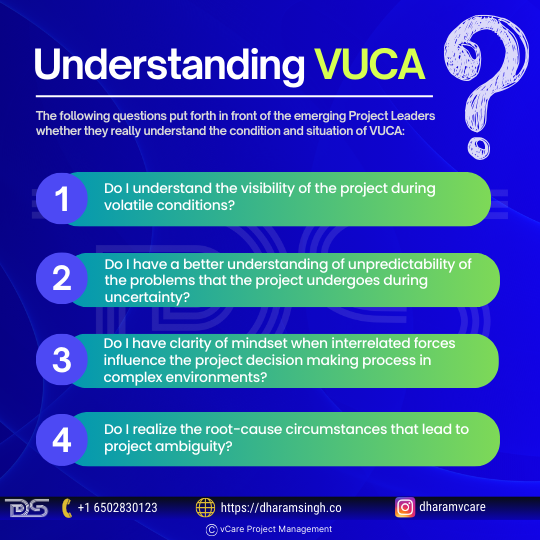
Understanding VUCA
Let’s get started with what VUCA stand for – Volatility, Uncertainty, Complexity, Ambiguity. It was formally developed by US Army War College in 1987 after the Cold War, to reflect how to oversee complex multilateral world situations. The acronym VUCA is derived from the leadership theories of Warren Bennis and Burt Nanus. Delivering value have direct correlation with the economic equation of the countries in which projects involved. The dynamics of environment changes impact the project success direction. Those adversaries needed to handle with focus mind, determination, perseverance by the Project Leaders. The following questions put forth in front of the emerging Project Leaders whether they really understand the condition and situation of VUCA:
- Do I understand the visibility of the project during volatile conditions?
- Do I have a better understanding of unpredictability of the problems that the project undergoes during uncertainty?
- Do I have clarity of mindset when interrelated forces influence the project decision making process in complex environments?
- Do I realise the root-cause circumstances that lead to project ambiguity?
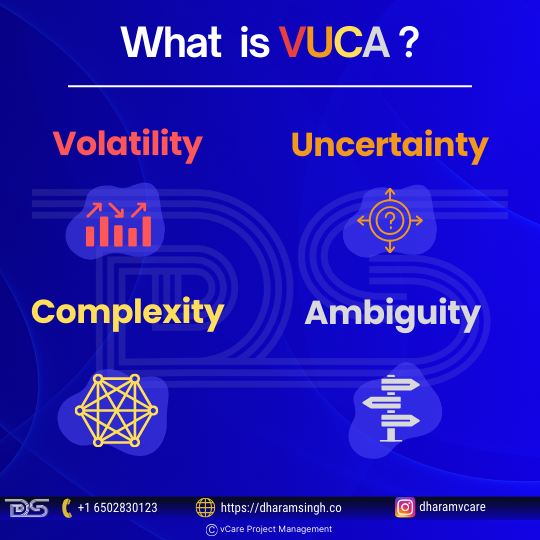
What is VUCA?
All these four questions streamline Project Manager to understand his unknowns – unknowns and better deal with this environment. Let us have a briefing on VUCA,
- Volatility: The rate of change or churn in business environment which directly affects the daily operations of the project. The Project Managers will always be in bed of thorns to mitigate the volatile situation and try to settle into normal rhythm.
- Uncertainty: The world is full of surprises when delivering value, that too for project managers it will be high potential for surprise due to lack of predictability in an uncertain environment. They need to have good assumptions capabilities to plan for future uncertainties.
- Complexity: Diverse global supply chain gets impacted directly with geopolitical, economical, dynamics of industries add complexities to the project success. Better observing of interrelated forces is need of the hour for the Project Managers.
- Ambiguity: The common misunderstandings and unclear realities cause project delays affecting the value delivery process. It naturally makes it difficult to construct risk mitigation plans.
The Impact on Project Management in VUCA World
VUCA influences project, program, and portfolio management, particularly in high-stakes environments. Whether it is a good sign or bad sign depends on the mindset of the Project Manager. Can we eliminate VUCA is a big question mark among the Project Leaders. We need collective responsibility when handling VUCA and one step at a time approach. Agile approach is good to proceed with but not the absolute one to stick on. As a project manager we need to dynamic and adapt to the changing environment and be hybrid to mitigate the risks and challenges VUCA environment brings into the project.

Thriving as a Project Manager in VUCA environment
Some tips for Project Manager to thrive in such environments:
Be Collaborative & Co-creative: Project Managers need to have meaningful collaborations with their team members. Their options, problem solving instance should be appreciated and involved in the decision-making process. Positive collaboration leads to positive co-creation combining for best value-based project delivery.
Be Innovative & Creative: Developing child-like mentality with outlook of creativity Project Managers can do wonders with innovations in their projects. Both have close twin knots, losing one will automatically supress the other.
Be sensible & communicative: Here we trigger the sensibility in voicing with clarity to your entire stakeholders – sponsors, team members, top management, external and internal state actors. Project Manager’s voice should be uniform throughout the top and bottom of the pyramid. This helps to face disruption with united response.
Be flexible & adaptable: Project Managers need to be flexible as grass, dancing to changes in project environment in the VUCA world. Adaption is a must from all levels which need patience and fair amount of training from the organization.
VUCA environment should be seen an opportunity rather than a challenge for organizations to thrive. These tips will be helpful for Project Managers to position themselves with resilience in such environments.
Strategic Leadership in a VUCA World
According to Wikipedia, Andrew Porteous quotes “Failure in itself may not be a catastrophe. Still, failure to learn from failure is.” Project leaders must understand there is no fool proof techniques to address VUCA environments. The only solution is fail fast, fail safe and learn from failures. While this mindset is difficult to grasp but have a sense of community to better positive predictions. Both introspections and evaluations needed to navigate and thrive in such environments. Connecting the dots between strategy and delivery results in better project outcomes. The Project Leaders performs the balancing act between the two. How well they balance need greater amount of critical analysis.
Cultivating Versatility
Developing adaptable leadership styles to manage unpredictable challenges aids the Project Leaders to manoeuvre better reliable strategies for projects. A pragmatic approach of leadership will enhance the decision-making process. The project duress created from the realms of political, economic, technical, social, market, nature calamities like Covid-pandemic gives a moral responsibility for leaders to rethink their leadership style. The harder problems of technological imbalances due to Artificial Intelligence (AI) making it difficult to craft strategies.
According to MIT Sloan Management Review, change management and emotional intelligence top the list of skills leaders to focus to steer the teams for project success. There is a serious limitation and notion of inadequate performance of leadership in these skills. So, organizations can address such extreme mishaps in their leaders by developing versatile leadership. Versatile leadership is forgoing continuous adjustments to their behaviour, meticulously applying right approach, to the right degree, for the circumstances at hand.
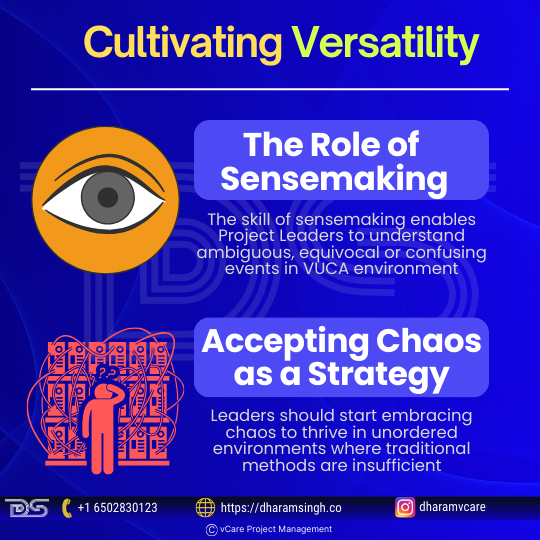
Cultivating Versatility
The Versatile Leader mind works in the absence of imbalance, fostering clear vision to handle tough environments. F. Scott Fitzgerld, in his 1936 essay “The Crack-Up,” quotes “the test of a first-rate intelligence is the ability to hold two opposed ideas in the mind at the same time, and still retain the ability to function.” This is the major challenge a Versatile Leader should pass by adoring wide and flexible range of behaviours
- The Role of Sensemaking: The root causes of imbalance is due to strategic-operational dualities faced by the leaders. The skill of sensemaking enables Project Leaders to understand ambiguous, equivocal or confusing events in VUCA environment. Sensemaking techniques aids for interpreting complex situations and making informed decisions in shifting markets. These capabilities help leaders to drive organizations forward, by having a clear 360-degree vision on environment they work upon.
- Accepting Chaos as a Strategy: Leaders should start embracing chaos to thrive in unordered environments where traditional methods are insufficient. From exponentially increasing technological advancements, economic and political aftershocks, disruptions like these have significant impact on the global supply chain. A well-engineered leadership mind will craft chaos as a strategy framework to streamline business operations for smooth project handling.
Balancing Speed with Thoughtfulness
In the fast-paced rapidly changing environment balancing speed with thoughtfulness is a daunting task for Project Managers. Ambitious targets in short durations leads to disrupt project progress leading to project delays and later project failures. Setting vibrant goals dominate the modern workplace. The thoughtfulness of leaders to change their conventional wisdom towards goal setting is key.
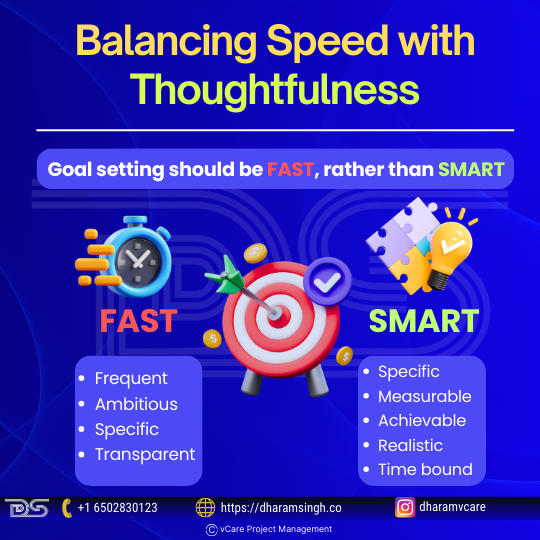
Balancing Speed with Thoughtfulness
As goals drives strategic execution of value delivery, interdependencies of silos plays a vital role for balancing the delivery value chain. A word of caution should always be there in mind of Project Managers when balancing speed with thoughtfulness. Goal setting should be FAST (frequent, ambitious, specific, and transparent) rather than SMART (specific, measurable, achievable, realistic, and time-bound) in VUCA environment.
The Danger of Speed-Centric Goals
Creating value quickly is the new paradigm shift, organizations seek to transform all or part of their businesses. Speed-centric goals lead to high performance of trajectory for the organization but do have the adversity of total failure push back. Proper prioritization of risks is needed to achieve rapid time-bound outcomes. The Project Leader should construct a rigorous cluster of plans in short-duration sprints to overcome potential long-term consequences with thoughtful value delivery.
Prudent Risk Management vs. Aggressive Growth
Too match the pace of market demands in the digital age, the pivot of risk-taking is quintessential for Project Leaders safeguard the organizational immune system. In today’s scenario avoiding risks is not a priority, leaders need to be proactively involved in identifying, evaluating, and strategizing risk mitigation plans. Risk-taking foster growth and innovation in VUCA world. Leaders should sharpen their risk management capabilities and be prudent. A prudent risk taker maintains calmness during uncertain times and able to show resilience with sound and rational decision-making. Rather than focusing on aggressive growth, Project Leaders need to navigate a path to smart growth. Organization’s reap multiple benefits by having “The Growth Corridor” balancing between minimum growth and maximum growth to drive innovation and survival at the marketplace.
Enhancing Communication and Team Adaptability
Organization’s stability dismantled when fear of disorders overlooks in the mind of employees from the top to bottom management. To overcome stagnation and steer through treacherous waters of VUCA, the Leader should communicate effectively. VUCA communication leans towards sleek perfection, setting clear direction and rallying behind employees’ voice. Leaders unify team adaptability call to action of cohesive strength to face the battle fluctuations and achieve value delivery.
Clear Communication in a VUCA Environment
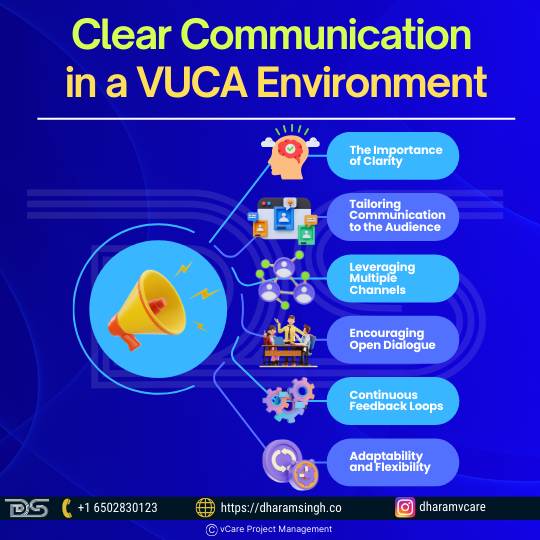
Clear Communication in a VUCA Environment
Effective communication is crucial yet challenging in VUCA world. Shifting dynamics of the workplace needs strategies not only communicate information clearly but make sure to reduce friction across the realms of the various verticals and horizontal in the organization. Let us walkthrough some of the effective VUCA Communication tips:
- The Importance of Clarity: Clarity in communication helps reduces misunderstandings, align team efforts, and reduce the friction that often arises in high-stakes, rapidly changing environments.
- Tailoring Communication to the Audience: Understanding the audience’s pulses to streamline communication.
- Leveraging Multiple Channels: Avoid bottlenecks and constraints by leveraging multiple channel communication.
- Encouraging Open Dialogue: Open dialogue fosters a culture of sensibility leading to more transparency, trust, and accountability, which are vital in uncertain environments.
- Continuous Feedback Loops: Creating continuous feedback loops allows teams to quickly adjust their communication practices as the environment changes.
- Adaptability and Flexibility: Both adaptability and flexibility not only improve clarity but also helps to maintain morale and cohesion among teams facing uncertainty.
Continuous Improvement of Skills
Keep pace with the evolving demands of a VUCA world, creating a learning organization is needed. It should need to be embedded into organizational culture fostering continuous improvement. According to Klaus Schwab in The Fourth Industrial Revolution, the integration of advanced technologies like Artificial Intelligence (AI) and Internet of Things (IoT) into everyday business processes means that the skills required today may be obsolete tomorrow. Continuous learning ensures that Project Managers can adapt to these rapid changing shifts, maintaining their relevance and effectiveness in VUCA world.
Conclusion: Thriving Beyond Boundaries
Embedding resilience into the Project Manager to thrive in VUCA world is a never-ending experience and experiment that organization keeps on retrospect for betterment. Delivering value in an increasingly boundaryless world, creating positive hopes of survival lies in the hand of versatile leaders. Such architecting leaders able to cultivate better systems, structures, culture, possibilities, and autonomous decision making to teams, in chaos.
The Project Leaders should develop: sensemaking with life-long learning, balance speed with thoughtfulness, managing risk with growth mindset, prioritize communication, skill development, foster a culture of continuous improvement, and embrace versatility, to deliver value in VUCA world.

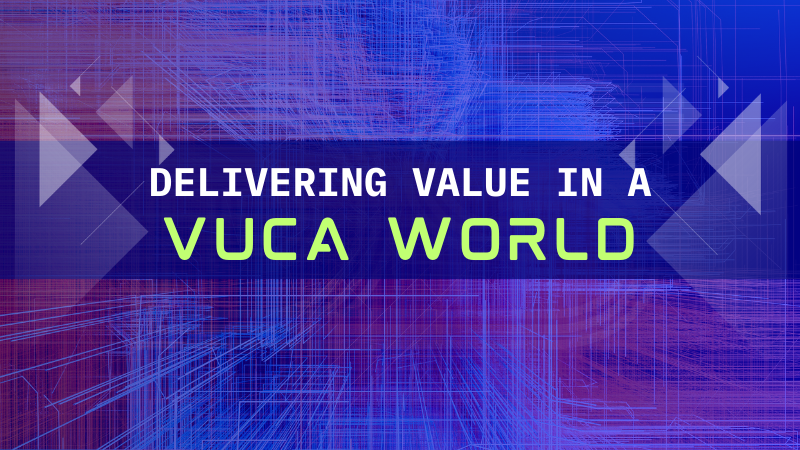
Recent Comments